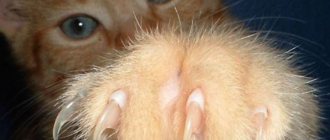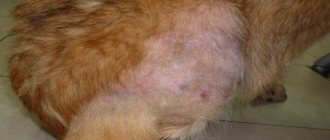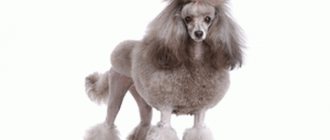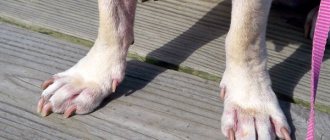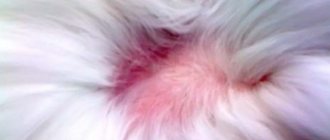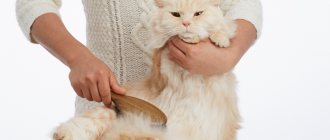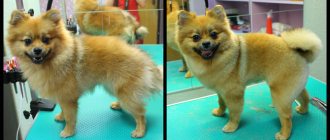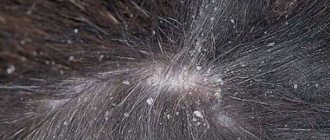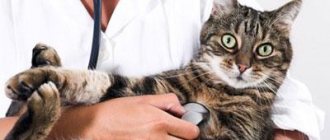Grooming a cat yourself is a responsible undertaking and should be approached with extreme caution. Grooming only makes sense if the cat is long-haired and in the summer, when it is hot. Or if a lot of mats have accumulated. Semi-longhaired, and especially shorthaired, cats do not need to be trimmed. This is unnecessary stress for them. We also do not recommend cutting an animal’s hair for “decorative” purposes, turning it into a lion or dragon simply for the sake of beauty.
How often to cut, including depending on the breed
The frequency of haircuts depends on the rate of hair growth, the age of the cat, and its health. It is recommended to cut your hair 2-3 times a year, not more often.
| Cause | Explanation |
| Hygiene | Long-haired cats get dirty very quickly, their fur rolls into lumps, and when licking, the likelihood of swallowing it is high, which can lead to problems with the digestive tract. |
| Shedding | Reducing the amount of wool on furniture. |
| Skin diseases (infections, parasites, hyperplasia of the sebaceous glands, dermatitis) | With short hair, a cat is easier to handle. |
| Exclusive view | Only for the purpose of participating in exhibitions. |
For Persians, a haircut is an ideal option, especially in the summer, as they quickly grow overgrown, and they also do not like heat.
What breeds of cats are prohibited from being cut?
- Shorthair (British, Scottish Fold). There is no particular point, only when absolutely necessary. Please note that there are long-haired types of these cats, namely British Longhair and Highland Fold, they need to be cut.
- With tipping or color-point color. After a haircut, the pet's color changes (becomes darker).
- Semi-long-haired breeds (Siberian and Norwegian forest cats, Maine Coon) do not need a haircut; you can only limit yourself to bathing and thorough combing. Their fur serves as an excellent protector from overheating and freezing. Also read how to properly bathe a cat and how to brush it on the Mister Cat portal.
In addition, you should not generally trim hyperactive pets, which are difficult to pacify and require the use of sedatives, which have a negative effect later.
What types of grooming machines are there?
Cats are cautious creatures and distrustful of objects that make sounds that are unpleasant to them. The worst irritant for them is hum and vibration. Some people never get used to the sounds of a hair dryer, much less the sounds of an electric clipper.
For such “nervous” people, a manual hair clipper, also known as a mechanical one, is quite suitable.
A mechanical cat clipper is easy to operate because... It is a pair of pliers with pruning shears fastened in the middle with a screw, which, after squeezing the handles in the palm of your hand, converge and cut off the hair caught between the pruning shears. Then, thanks to the spring mechanism, the blades of the pruning shears move apart, and the machine is ready to cut the strand again.
This is an almost ideal mechanism that does not damage or frighten the cat with vibration, but it has 3 significant drawbacks:
- If the “lamb” is adjusted incorrectly, the blades will not close completely and pull out the wool instead of cutting it.
- Low cutting speed.
- Such a manual clipper is not very suitable for performing a curly, high-quality haircut.
Electric cat clippers also have their pros and cons:
- Pendulum
Advantage - low price
Disadvantage: due to its low power, it cannot be used as a professional grooming tool. And the quality of the knives leaves much to be desired.
- Vibrating
These are suitable for cats with soft, medium-length fur.
Advantages – low noise hair trimmer.
Disadvantage: cannot be used for long-haired or dirty cats; the blades clog too quickly.
- Rotary machine
Advantages: high power, ability to easily remove hair of any length and thickness. Quick change of high-quality attachments. Air cooling system and the possibility of long-term curly haircuts (professional grooming machine).
The disadvantage is that it is noisier than a vibrating machine. Expensive.
Whatever machine you choose, you must first learn how to handle it before your cat gets under the blades of the clipper.
An important point: not a single ordinary “human” machine for removing hair or trimming whiskers is suitable for representatives of the cat family! Only specially created for cat grooming!
Since the question “Is it possible to cut cats?” - was decided positively, and we even figured out what is the best way to do it, the last topic remains: “Who should do the haircut and how?”
How to cut a cat's hair: types of haircuts
| Type of haircut | Description |
| Exhibition (Harlequin, Continental, Modern)
| Emphasizes the extravagance of the animal. |
| The Dragon | On the back and tail, scraps of fur are left in the form of small triangles that form a mohawk (the shape can be different). The head and limbs are not cut. |
| French lion | Used both for hygiene purposes and as a model. Great for summer. They cut off everything on the body, leaving the head intact, a small tassel at the tip of the tail, and the part below the knees on the paws. |
| Puss in Boots | They expose the entire body, bypassing the head, tail and paws. |
The process of cutting a cat with scissors
To groom a cat at home, it is important to have someone help hold it for the first time. The cat is placed on its side and its limbs are supported. You can use a plastic collar for safety.
Before the procedure, it is important to disinfect the instrument with alcohol so as not to infect the animal in case of injury.
Using scissors, you should immediately cut off tangles and any areas of matted fur. Then proceed directly to the haircut:
- The head is treated. Usually the head is not cut bald, leaving a fluffy hairstyle, but it is better to immediately trim off the excess overgrown strands and hair. It is important not to touch the whiskers, but it is better to remove the “whiskers” - it will be easier for the pet to eat and keep clean.
- Remove excess volume from the body, neck and behind the ears, paws and tail.
- Pay special attention to the intimate area; it is important not to damage these areas with scissors.
After finishing, you should wash the cat and dry it thoroughly with a hairdryer, removing excess hair.
Choosing Cat Grooming Tools
The haircut can be carried out using scissors (medium size, sharp with rounded ends) or a clipper, preferably silent, so as not to frighten the pet. The latter method is more effective and safer - there is practically no possibility of injuring the animal, and the result is guaranteed: a uniform haircut with the ability to choose the desired length of fur.
Auxiliary tools:
- soft comb;
- textile;
- hydrogen peroxide or chlorhexidine (needed if you injure an animal);
- toys and treats;
- table (or other surface).
It is better to immobilize the cat during the procedure. For example, wear a special collar. It is better for the second person to hold the cat and calm it while the first haircut is performed.
If the animal is very aggressive, it is better to visit a veterinary clinic. In some cases, anesthesia may be needed. It is worth doing it only if there is no other option. For example, a cat is covered in tangles and it’s hard for him.
What to do if you accidentally hurt your cat?
Sometimes even the most careful actions can lead to injury. What to do if the cat is still injured? You should have iodine or hydrogen peroxide with cotton swabs on hand. Apply a small amount of antiseptic solution to cotton wool and gently rub the skin around the cut to stop bleeding, you can press a dry cotton swab against the wound for a few minutes.
Please note: in such an unpleasant situation, you should not panic. It is advisable to calm the animal by telling it in a quiet voice the kind words that you are used to saying in a normal situation. While grooming, you should under no circumstances raise your voice to the cat or speak in a raised voice with your partner, make sudden movements, and especially not use physical force (we are talking about hitting, pinching and other actions).
Thus, grooming a cat at home using clippers and scissors is, first of all, a hygienic event aimed at maintaining a neat appearance of the pet. If you are going to prepare your cat for a show or other important event, it is recommended to schedule a decorative haircut with a professional groomer. In clinics, decorative haircuts for cats are done using light anesthesia or sedatives. However, it should be remembered that constant exposure to such medications can adversely affect the health of your pet.
Preparing for a haircut
The preparatory steps are as follows:
- Examine the cat. If there are skin lesions, it is recommended to reschedule the haircut. However, you don’t have to do this; then the wounded area needs to be carefully trimmed so that the wound is visible.
- Wash your pet.
- Decide on a tool. It should be well pointed.
- Choose the right time. The best thing is a period of rest, since while the cat is awake, it can injure both itself and the person.
What is grooming
Grooming is not a newfangled word from a glamorous magazine, it is a serious branch of services related to the veterinary industry, which includes, first of all, the hygienic part, and only then the aesthetic part.
Hygiene is essential for all animal species, not just humans. Just like a person, an animal needs to tidy its nails, claws, ears and hair from the very first days of life.
At first, the mother cat does this, and then the kitten tries to do its own toilet: sharpening its claws, washing itself, licking its fur. The task of a grooming specialist is to help the animal look neat and not get sick. A clean, well-groomed animal is a clear sign of a responsible, loving and prudent owner.
Grooming includes not only cleaning the ears and trimming the claws, but also trimming the “extra” hair.
Mr. Cat recommends: step-by-step instructions for grooming a cat
- Prepare all necessary tools and disinfect them.
- Trim the nails with a nail clipper or using regular nail scissors. Take the animal's paw, press on the pad and trim the claw. Read the article about how to choose a nail clipper for a cat, what they are like and how much they cost.
- Immobilize your pet by placing it on its side and holding its paws.
- In case of aggressive behavior, wear a special plastic collar.
- Immediately cut the fur from the sides, then from the back and belly. Take special care in the nipple area.
- The skin should be taut to avoid injury. It is better to remove tangles with scissors, preferably before cutting or as you find them.
- You can cut both against hair growth and along.
- At the end of the work, the cat should be wiped with a damp cloth.
Why cut your cat's hair?
The main purpose of grooming animals is to care for their fur.
Cats have a natural need to constantly care for their fur coat. But very often this is not enough, especially for fluffies with a fur length of more than 3 cm. Special care is recommended for such pets, including regular combing, removing tangles and trimming excess hair.
Cat trimming procedure
The cat trimming procedure consists of the following steps:
- It is necessary to fix the pet in a position lying on its side, holding it by the hind and front legs.
- First of all, the tangles are cut off with scissors. After this, they continue cutting the hair on the sides of the body and back using a clipper.
- When trimming fur from the belly, you should carefully avoid the nipples and intimate areas. Experts recommend first cutting the hair in intimate areas with scissors and then completing the manipulation with a clipper. It must be remembered that cats' skin is very thin and easily injured. Therefore, while working with the machine, you need to tighten it so that skin folds do not get under the blades.
- At the end of the procedure, the cover on the paws is cut off.
- The hair on the animal's head is not trimmed; it is possible to shape it with thinning scissors. It is strictly forbidden to trim the mustache, as it is an important organ of touch.
- Tail trimming is carried out at the request of the owner.
If you can’t cut your cat’s hair in one procedure, you can divide it into several stages. This will allow the pet to avoid unnecessary stress, and the master from bites and scratches.
After grooming, the animal must be bathed and dried with a hairdryer. If your cat is afraid, you can remove cut and stuck hairs by wiping it with a damp cloth or chamois cloth. During the cold season, you should create a comfortable microclimate without drafts in the room where the pet is.
After the haircut
As we have already said, after grooming the cat should be wiped with a damp cloth, and it is also worth combing it. As a rule, cats easily get used to their trimmed appearance. But some problems may arise:
- The cat may get injured when scratching or playing the first time after the haircut.
- May begin to lick itself more often and exhibit slight irritation.
- In rare cases, the behavior may change and aggression may appear: the cat damages furniture, defecates in inappropriate places, or attacks.
If the cat’s behavior does not return to normal on its own, then you need to contact a veterinarian.
If the cat is injured
If it was not possible to avoid injury from scissors or clippers when grooming a cat, immediate measures must be taken to eliminate the consequences:
- wipe the cut area with a disinfectant;
- apply healing ointment with a bandage or plaster; it is better to use a bandage so that the pad does not fall off when moving.
In case of deep and lacerated wounds, surgical intervention is required - it is better to take the cat to the veterinarian or call a doctor at home. Eye damage is especially dangerous; in this situation, consult a doctor immediately.
Precautions when cutting
When choosing a hair clipper at home, preference should be given to models that operate on mains power. You should not purchase them with a small blade to avoid injury; the minimum length is 0.5 mm.
It is important for the owner not to worry during the haircut, otherwise his anxiety will be passed on to his pet.
Avoid overheating the machine.
For long-haired cats, using scissors is ineffective.
To ensure normal thermoregulation of the animal, it is recommended to cut the hair not too short.
Reasons and frequency of haircuts
Cats need to be trimmed from time to time for several reasons. Most often, this activity should be carried out with animals that have long hair, due to its constant rolling into clumps, which cause numerous inconveniences. Cat haircuts can have different purposes:
- For hygiene purposes. In this case, the process is necessary due to the wool becoming tangled and matted. The animal may get too dirty, and the type of contamination will be paint products or certain building materials that cannot be removed with shampoo.
- In certain situations, the fur of very old or sick cats that are unable to take care of their “fur coat” is shortened. This procedure prevents the formation of hair balls in the stomach, which often cause intestinal blockage. It is also necessary in conditions of elevated air temperatures, when there is a risk of overheating of the pet.
- Due to prolonged molting. In this case, cutting will make keeping the animal much easier.
- For medicinal purposes. For certain diseases of cats, haircutting may be recommended by a veterinarian. Indications for such a procedure are usually infectious skin diseases, dermatitis, the appearance of various parasites, as well as hyperplasia of the sebaceous glands. Trimmed wool makes it possible to treat the skin with medications more effectively, and this significantly shortens the treatment process.
- Decorative haircuts. Such hairdressing services for pets are nothing more than a whim of their owners. With the help of a model haircut, owners try to emphasize the individuality of their pet and the characteristics of its character.
- Exhibition haircuts are designed to demonstrate the standards of their breed in animals.
The frequency of procedures associated with shortening hair depends on the intensity of its regrowth. This usually takes from three to six months, depending on the breed of the pet, its health condition and age. On average, it is recommended to provide cats with such hairdressing services no more than two or three times a year.
Removal of tangles should be carried out as they appear.
Model haircuts can be performed more often, but in this case the health of the animal, the condition of its coat, and the season of the year should be taken into account. Therapeutic and hygienic haircuts are usually carried out as needed.
How to choose
When choosing the right tool, you should consider several points:
- animal size;
- coat length and texture;
- haircut goals.
So, for a general Maine Coon haircut, you need to choose scissors with a longer cutting blade than for a Highland haircut. But for an owner who has no experience in cutting hair, it will not be comfortable to work with long scissors, so it is recommended to choose a medium size blade.
To create rounded shapes on the face and paws, short scissors with rounded ends are suitable, as are small thinning scissors.
Scissors for cutting tangles come only short.
Before purchasing, the owner is recommended to hold the instrument in his hand to evaluate the comfort.
To cut or not to cut
It is important to understand that not all cats can and should be subjected to this procedure. So the following are a kind of contraindication:
- colorpoint and tipping colors - as the fur grows on the back and belly, it will become several tones darker than before cutting;
- disgusting character and violent temperament, when the animal does not give in to any persuasion. Of course, you can cut it under anesthesia, but in this case, evaluate all the possible risks associated with the administration of narcotic drugs: cardiac arrest, coma, failure of the liver and kidneys. As a last resort, sedatives and muscle relaxants are used instead of drugs, but only after approval of the appropriateness of their use by a specialist and under his clear guidance;
- Without an urgent need, there is no point in cutting short-haired cats - the heat does not particularly interfere with normal life activities, and they never have mats;
- Smooth-haired animals are cut only in extreme cases, for example, when they have been worn in oil paint and it is easier to shave the animal than to try to rub off the matted multi-colored wool.
Recommendations from experts
The procedure for grooming domestic cats is a last resort; as a rule, it is resorted to due to the systematic formation of mats or the need for treatment based on medical indications. In most cases, animals with long hair undergo a similar process.
To prevent pets from getting tangled, it is recommended to comb them with special devices: a slicker brush and a furminator. In addition, animals need to be washed using high-quality products that help maintain the well-groomed condition of their “fur coat”. Such actions not only have a beneficial effect on the health of animals, but also relieve their owners from scraps of fur scattered throughout the house.
You should know that if someone in your household is allergic to a pet’s fur, cutting the pet’s fur will not help. This is explained by the fact that in this case the reaction of the immune system is caused directly by the skin secretions of the animal, as well as by its saliva preserved on the hair.
The coat of cats belonging to semi-longhaired breeds not only protects them from the cold, but also prevents overheating. This type is not inclined to form tangles and only needs regular bathing and combing. This applies to species such as Maine Coon, Norwegian and Siberian cats.
Persian breeds have thin and delicate fur, which after shearing is restored much easier than that of their counterparts. Persians have a very difficult time withstanding hot weather , so their coat is often shortened.
Pros and cons of grooming
Supporters of pet grooming and their opponents have ongoing debates about the positive and negative aspects of grooming. Owners who are of the opinion that grooming cats of long-haired breeds is not a whim, but a necessity, are definitely right. It is advisable to carefully consider all the pros and cons before going to a cat beauty salon.
Pros of grooming:
- No wool deposits on upholstered furniture and clothing.
- It is easier to wash your pet and there is no need to dry it with a hairdryer.
- In summer, the cat does not languish from the heat.
The protests of cat owners who express a negative position regarding visiting pet hairdressing establishments are understandable. And they are based, first of all, on the fear of harming a defenseless creature. But you need to approach any event sensibly: if you eliminate all possible risks when carrying out grooming, then if the need arises, you can do a pet haircut.
Minuses:
- Stress for a pet that is unaccustomed to interference in its life from strangers.
- Possible abrasions on the cat’s body if hairdressing manipulations are performed by an unprofessional master.
- Undesirable consequences of using anesthesia in case of an allergic reaction.
What tools will you need?
Cat hair is thin and thick, so simple scissors and clippers will not work for human hair. The cat grooming tool is selected from among the specialized grooming tools:
- Combs: flat metal comb, slicker brush (without droplets);
- Thinning scissors (mostly) or straight with rounded ends;
- Animal shaving machine and suitable knives;
- Hairdryer with high power (with the ability to turn off the heating);
- Claw cutter;
- You may need fixing accessories (if the cat is not giving in).
To groom pets, you need a special tool.
An important element of cat grooming is the table. The person who shears the animal must approach it from any direction. The rubber, non-slip surface will provide convenience and safety.
If a person has to bend over too much during the process, pain in the back and neck begins. In addition, the table should be well lit. If there is no special table for groomers at home, use another stable table with a non-slip mat on it.
If owners are afraid to cut their cat's hair, a normal haircut will not work. Animals feel fear and aggression and resist.
Let's go to the grooming salon
When the owner of a furry purr does not have enough skills and opportunities to groom the animal on his own, a decision is made to change the image of the pet by the masters of the grooming salon.
Grooming experts will do the job efficiently and quickly, with minimal discomfort for the cat.
When deciding to take your pet to the cat barber, you should remember the following nuances:
- During the trip, the cat may become agitated and behave aggressively in the future;
- the cost of a haircut depends on the type of hairstyle - model ones are more expensive than hygienic ones (the latter cost from 1-1.5 thousand rubles);
- the result depends not only on the skill of the groomer, but also on the condition of the animal’s coat;
- If the master is unable to cope with a frightened pet, a sedative injection may be offered, which does not have the best effect on the health of the purr.
The best way to change the appearance of your pet is to call a grooming specialist to your home. After all, in a familiar environment, it will be easier for the animal to endure the grooming procedure with minimal stress. And a professional hairdresser will not harm the cat, delicately removing excess hair from the most difficult and sensitive areas.
Video: cutting a cat in a grooming salon
Which cats should not be cut?
Owners of colorpoint and tipping cats are often interested in the question of whether their pets can be cut. This procedure will not affect their health in any way, but if the cat is a breeding cat, then it should be taken into account that after the haircut, the hair that grows back on the back and belly will be several tones darker.
Animals with a violent temperament that are not amenable to persuasion should not be cut unless absolutely necessary. The same applies to short-haired pets. They are not bothered by the heat, the fur does not tangle, so only if the cat gets very dirty, for example, with oil paint, is it easier to trim it than to wash it.
